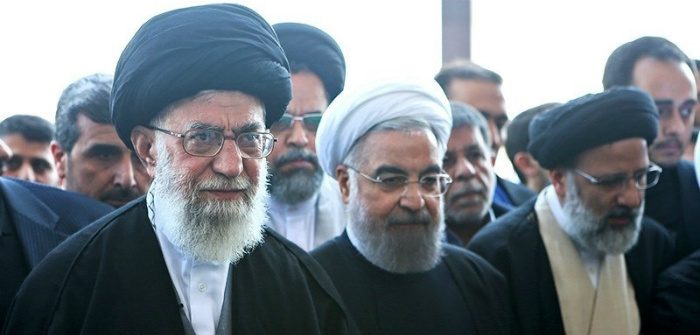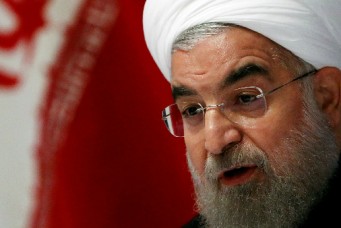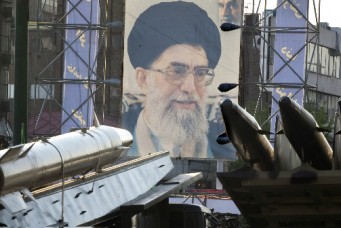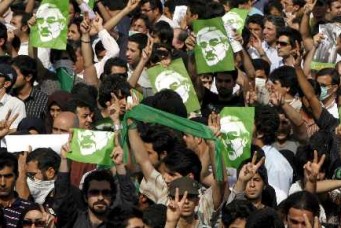Iran’s Evolutionary Road to Reform
Reformists leaders have disappointed hopes for change before. Yet Hassan Rouhani benefits from a unique opportunity.

Ayatollah Ali Khamenei and President Hassan Rouhani at the funeral of a leading cleric, Mashhad, Iran, March 5, 2016. Wikicommons
Iran faces long-standing challenges to political and economic reform, despite recent optimism over President Rouhani’s leadership. Last year’s nuclear deal removed the shadow of war and brought Iran out of the cold of sanctions and political isolation. New breathing room for Iran’s leadership and its people could present a chance for change. Or this could turn out to be yet another missed opportunity. Most likely however it will contribute to a slow process of evolutionary reform in Iran.
The tensions over Iranian identity, somewhere between Islamic and Republic, has been one of the biggest internal obstacles for reform ever since the 1979 revolution. State authorities and in part Iranians themselves have sought to combine modernity, nationalism, and religious ideology. Achieving a balance has been a trial and error experiment that has challenged the pace of progress in almost all major areas, from the economy to human rights. In today’s Iran loyal adherents to the country’s revolutionary legacy continue to resist new and largely youthful forces for change that are perceived to undercut the ideological values of the 1979 uprising.
This delicate balancing act has also yielded competition between elected and unelected power centers inside Iran who aim to advance differing interpretations of the Islamic Republic. Traditionally, the unelected organs such as the judiciary, the Guardian Council and the Revolutionary Guards have been the bastions of Iran’s Islamic ideology, and resistant to reforms, while elected bodies like the parliament and the executive have largely, albeit not always, pushed for change by appealing to nationalism and republicanism.
A related problem has been the swing of political leadership in recent decades. Fallouts between Ayatollah Ali Khamenei and most Iranian presidents during their second terms in office have exacerbated this. When former president Mohammad Khatami became the first leader of the reformist bloc to attain such a position, for example, the push for reform arguably took place too fast. This caused a backlash from hardline opposition groups that inevitably resulted in a long-term setback to the reformist movement.
The Khatami government effectively had its hands tied by opposition from the so-called “hardliners”. He was unable to deliver on substantive change such as an economic opening, greater freedom of the press, opening spaces for political debate, and relaxing social restrictions. This left many reformist supporters disillusioned. Under his successor, President Mahmoud Ahmadinejad, Iran experienced one of its worst periods of state control over personal freedoms. Many of the reforms initiated under Khatami were undone. In some ways Khatami and Ahmadinejad represented two different versions of radical change for Iran, both of which proved unsustainable at the time under the Islamic Republic.
Hassan Rouhani is perhaps the first president under the Islamic Republic that can succeed at creating consensus between competing factions around a centrist position. This has led to recent and novel crossover between reformist and conservative power factions within the leadership system. A fragile consensus that Rouhani’s centrist position offers may ultimately be the best viable option for the Islamic Republic. Iran’s agreement to and continued implementation of the nuclear deal, bitterly opposed by powerful opposition groups, is an indication of this. The main basis for the success of Rouhani’s strategy (and arguably the raison d’être behind the nuclear agreement) was that both conservatives and reformists saw an urgent necessity to fix the Iranian economy.
To achieve the full economic potential from the nuclear deal, Iran will need to also tackle endemic mismanagement and corruption across the private and public sector. Last year the World Bank ranked Iran as 118 in its ease of doing business index. To attract large sums of foreign investment the government will need to implement a series of economic reform initiatives including privatization, investor friendly regulation, and market liberalization.
Invariably some conservative thinkers and business interests will oppose economic reforms, especially those that increase regulation and transparency. Business entities linked to the Pasdaran (the common name for the country’s elite Revolutionary Guards) and religious endowments also worry that Rouhani’s reform risk undercutting their profit margins. Anti-West power factions are likewise opposed to opening up the economy to European and American money. However, the results of the parliamentary elections this year, in which the so-called “List of Hope” candidates aligned with Rouhani won 42 percent of seats, have created new optics in the legislative branch that are likely to be more supportive of economic reforms.
Corruption and economic mismanagement is part of a wider problem with good governance and human security chronic across the Middle East and North Africa. For Iran, high unemployment (now estimated at roughly 11.7 percent), and deep wealth disparity between social classes, have been a dominant source of widespread dissatisfaction with the governing elite. Additionally the rule of law and civil liberties have become back-seat issues against mounting domestic security measures. While the situation is better than that experienced under Ahmadinejad’s tenure, it has taken a downturn in comparison to the early days of the Rouhani presidency. Over the past year, the Revolutionary Guards, in confronting threats posed by ISIS and responding to Khamenei’s warnings against foreign infiltration, have tightened control over Iranian politics and society.
External factors have also acted as obstacles to change inside Iran. The most lethal has been Western sanctions policies over the past thirty years that intentionally aimed to squeeze the Iranian economy and narrowed options for economic reform. The sanctions imposed by United States and European Union in recent years also had the unintended consequence of creating fertile ground for the growth of the black market and corruption in the Iranian economy. The decades-long experience of sanctions, in addition to recent events in Libya and Syria, have provided ammunition to those, like Ayatollah Khamenei, who believe the West seeks regime change in Iran.
The U.S.-backed democratization programs under President George W. Bush are fresh on the minds of Iran’s security establishment. Thwarting such perceived Western ploys has formed the basis for greater state control over private citizen life and created enormous challenges for genuine grassroots reformist groups to thrive and sustain their activities. Since the inception of the Islamic Republic, there has been an unhealthy Western preoccupation for influencing or waiting for the leadership in Iran to transform rather than dealing with the reality of what it is. Even under Khatami, when Iran played a constructive role in Afghanistan after the U.S.-led 2001 invasion (and later secretly offered to cut a comprehensive deal with the U.S. on regional issues), it was rebuffed and labeled a part of the “axis of evil”. The mistakes of this approach were all too clear after Ahmadinejad replaced Khatami. It would be negligent on the part of the West to make similar mistakes with Rouhani.
The regional context further aggravates challenges to reform inside Iran. Iraq and Afghanistan, which have large porous borders with Iran, are currently in a state of armed conflict with internal opposition groups and facing central government breakdown. Iran’s other major neighbor, Turkey, is engaged in a risky conflict with the Kurds while simultaneously dealing with homeland security blows from ISIS and attempted coups. Iran itself is deeply engaged in both Iraq and Syria’s bloody conflicts. Widespread political violence, and especially the fight against ISIS, helps distract attention from urgently needed domestic reforms.
Yet there remains hope for serious change. As many Iranian reform activists who were in favor of the nuclear deal have argued, paving the path for Iran’s reintegration into global economic and political platforms is likely to be conducive to their work in the longer term. In the aftermath of the 2009 “Green Movement”, it became clear that Iranians had no appetite for revolutionary change. In the years since, and in light of Iran’s own experience with the 1979 revolution and the fate of countries that experienced the Arab Spring, those driving reform in Iran have seemingly decided on an evolutionary pace that requires an approach of non-violence and strategic patience.
The West is likely to find such a slow pace unpalatable. While Western policymakers should not shy away from expressing discontent, the wisest thing they could do is create an environment for engagement with Iranians and allow those working inside Iran to decide how far and how fast to press for reforms.
Elham Geranmayeh is a policy fellow for the Middle East and North Africa Programme at the European Council on Foreign Relations. On Twitter: @EllieGeranmayeh.




